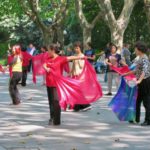Earlier this year, NYT printed my words on its website. For an amateur writer like myself, this was a big deal. Sure, my journalists friends are publishing on big name publications all day long like it’s no big deal, but for me, it was rather out of the ordinary.
It began during my trip to Ethiopia back in February. I was traveling without my laptop, and only connecting to the world via occasional spotty Internet on my smartphone. My journey was making a significant impression on me, stirring up memories and thoughts about my time in the Peace Corps that I haven’t had in a long while. I was having many conversations with my friend, whom I was visiting, about foreigners’ lack of cultural sensitivity when working in development. And not just in development, I related our discussions to foreigners that I’ve witnessed in Shanghai as well.
It was during an afternoon at the Sheraton in Addis, when we were taking advantage of the fast Internet that I saw a friend had forwarded NYT’s questionnaire titled, “How Did Your Recent Peace Corps Service Affect Your Life?” Given the conversations that I was having, I had a lot to say. So, on my tiny smartphone, I typed out the 200-word response to the questionnaire, hit sent, and then forgot about it.
A month later, I get an email with the subject line, “Hi from the New York Times”. You know, in the movies, people usually get calls from the NYT, and then they freak out? Well, I got an email, but rest assured, it was equally exciting. The editor wanted to publish my story, and naturally, given that it is the NYT, gave me a short deadline. So I squeezed an hour in my schedule that night and edited my response to the initial questionnaire into a 400-word essay. This was early March.
A few months went by, and I began to think perhaps they decided to not run the story after all, and then early June, I get another email from the editor. This time, confirming that they will run the story, and requested a picture that depicts me during my service. Oh boy.
Then began one of the most agonizing decisions I’ve ever made. I put a selection of photos on Facebook, crowdsourcing ideas. It is only then that I realized I had very few pictures of myself, showing me working in my village. Naturally, why would I? Most people do not have pictures of themselves working in their cubicles. The decision came down to a very nice quality photo, but depicting a cliché of me and smiling children vs. lesser quality photo that is less cliché.
It was agonizing. I gave far less thought about whether to spend two years of my life in a village than which silly photo to depict those two years.
It frustrated me that taking a photo with African children was cliché. Had I served in a country with white children, I’m pretty sure no one would think it’s cliché. Children are cute, and people like taking photos with them. Not to mention kids in the village love posing for photos with me, and then seeing their faces on camera. This was the reality of life in village, yet, because mainstream media has ruined that image, I was then pressured to make the “responsible” choice to not perpetuate the stereotype.
In the end, I went with the best quality photo of the smiling children and me. My Ghanaian-American friend, Karen, who works at the Washington Post convinced me with the following argument, “Centuries of narrow medial portrayal is not your fault. You are Asian, and they are black. That’s fact. It’s not worth picking a bad photo just to avoid someone says it’s cliché.” I trusted her judgement, and made the decision.
A month later, the story came out as a companion piece to a sadder Peace Corps story. But nevertheless, my name and my words were in print (digitally) in the New York Times! Hopefully it’s not the last time. I welcome you to have a read. My story is the second one in the series, “Peace Corps Volunteers in Their Own Words”. Let me know what you think!







1 thought on “That Time When NYT Published My Words”
Comments are closed.